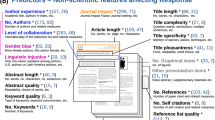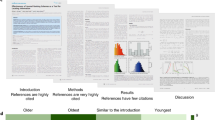Abstract
Citation frequency is often used in hiring and tenure decisions as an indicator of the quality of a researcher’s publications. In this paper, we examine the influence of discipline, institution, journal impact factor, length of article, number of authors, seniority of author, and gender on citation rate of top-cited papers for academic faculty in geography and forestry departments. Self-citation practices and patterns of citation frequency across post-publication lifespan were also examined. Citation rates of the most-highly cited paper for all tenured forestry (N = 122) and geography (N = 91) faculty at Auburn University, Michigan State University, Northern Arizona University, Oklahoma State University, Pennsylvania State University, Texas A&M University, University of Florida, University of Massachusetts, University of Washington, and Virginia Tech were compared. Foresters received significantly more citations than geographers (t = 2.46, P = 0.02) and more senior authors received more citations than junior researchers (r 2 = 0.14, P = 0.03). Articles published in journals with higher impact factors also received more citations (r 2 = 0.28, P = 0.00). The median self-citation rate was 10% and there was no temporal pattern to the frequency of citations received by an individual article (x 2 = 176). Our results stress the importance of only comparing citation rates within a given discipline and confirm the importance of author-seniority and journal rankings as factors that influence citation rate of a given article.



Similar content being viewed by others
References
Adam, D. (2002). The counting house. Nature, 415(6873), 726–729.
Aksnes, D. W. (2003). A macro study of self-citation. Scientometrics, 56(2), 235–246.
Anderson, R. C., Narin, F., & McAllister, P. (1978). Publication ratings versus peer ratings of universities. Journal of the American Society for Information Science, 29(2), 91–103.
Bonzi, S., & Snyder, H. W. (1991). Motivation for citation: A comparison of self citation and citation to others. Scientometrics, 21(2), 245–254.
Bornmann, L., & Daniel, H. D. (2008). What do citation counts measure? A review of studies on citing behavior. Journal of Documentation, 64(1), 45–80.
Borrego, A., Barrios, M., Villarroya, A., & Ollé, C. (2010). Scientific output and impact of postdoctoral scientists: A gender perspective. Scientometrics, 83(1), 93–101.
Bridgstock, M. (1991). The quality of single and multiple authored papers—An unresolved problem. Scientometrics, 21(1), 37–48.
Castellano, C., & Radicchi, F. (2009). On the fairness of using relative indicators for comparing citation performance in different disciplines. Archivum Immunologiae et therapiae Experimentalis, 57(2), 85–90.
Chen, C., Song, I. Y., Yuan, X., & Zhang, J. (2008). The thematic and citation landscape of Data and Knowledge Engineering (1985–2007). Data and Knowledge Engineering, 67(2), 234–259.
Chen, C., Sun, K., Wu, G., Tang, Q., Qin, J., Chiu, K., et al. (2009). The impact of internet resources on scholarly communication: A citation analysis. Scientometrics, 81(2), 459–474.
Chew, F. S., & Relyea-Chew, A. (1988). How research becomes knowledge in radiology—An analysis of citations to published papers. American Journal of Roentgenology, 150(1), 31–37.
Cole, S. (1979). Age and scientific performance. Journal of Sociology, 84(4), 958–977.
Copenheaver, C. A., Goldbeck, K., & Cherubini, P. (2010). Lack of gender bias in citation rates of publications by dendrochronologists: What is unique about this discipline? Tree-Ring Research, 66(2), 127–133.
Ding, Y., & Cronin, B. (2011). Popular and/or prestigious? Measures of scholarly esteem. Information Processing and Management, 47(1), 80–96.
Dries, N., Pepermans, R., & Carlier, O. (2008). Career success: Constructing a multidimensional model. Journal of Vocational Behavior, 73(2), 254–267.
Figà-Talamanca, A. (2007). Are citations the currency of science? Journal of European Psychoanalysis, 24(1), 155–164.
Hakanson, M. (2005). The impact of gender on citations: An analysis of college & research Libraries. Journal Of Academic Librarianship, And Library Quarterly. College & Research Libraries, 66(4), 312–322.
Hutson, S. R. (2002). Gendered citation practices in American antiquity and other archaeology journals. American Antiquity, 67(2), 331–342.
Larivière, V., & Gingras, Y. (2010). The impact factor’s Matthew effect: A natural experiment in bibliometrics. Journal of the American Society for Information Science and Technology, 61(2), 424–427.
Ledin, A., Bornmann, L., Gannon, F., & Wallon, G. (2007). A persistent problem—Traditional roles hold back female scientists. EMBO Reports, 8(11), 982–987.
Lee, S. Y., Lee, S., & Jun, S. H. (2010). Author and article characteristics, journal quality and citation in economic research. Applied Economic Letters, 17(17), 1697–1701.
Leimu, R., & Koricheva, J. (2005). What determines the citation frequency of ecological papers? Trends in Ecology and Evolution, 20(1), 28–32.
Lewison, G. (2001). The quantity and quality of female researchers: A bibliometric study of Iceland. Scientometrics, 52(1), 29–43.
Lillquist, E., & Green, S. (2010). The discipline dependence of citation statistics. Scientometrics, 84(3), 749–762.
Long, J. S. (1992). Measures of sex-differences in scientific productivity. Social Forces, 71(1), 159–178.
Luzar, V., Dobric, V., Maricic, S., Pifat, G., & Spaventi, J. (1992). A methodology for cluster-analysis of citation histories. Quality and Quantity, 26(4), 337–365.
MacRoberts, M. H., & MacRoberts, B. R. (1989). Problems of citation analysis: A critical review. Journal of the American Society for Information Science, 40(5), 342–349.
Over, R. (1988). Does scholarly impact decline with age? Scientometrics, 13(5–6), 215–223.
Padial, A. A., Nabout, J. C., Siqueira, T., Bini, L. M., & Diniz-Filho, J. A. F. (2010). Weak evidence for determinants of citation frequency in ecological articles. Scientometrics, 85(1), 1–12.
Parker, J. N., Lortie, C., & Allesina, S. (2010). Characterizing a scientific elite: The social characteristics of the most highly cited scientists in environmental science and ecology. Scientometrics, 85(1), 129–143.
Penas, C. S., & Willett, P. (2006). Gender differences in publication and citation counts in librarianship and information science research. Journal of Information Science, 32(5), 480–485.
Petersen, A. M., Wang, F., & Stanley, H. E. (2010). Methods for measuring the citations and productivity of scientists across time and discipline. Physical Review E, 81(3 Pt 2), 036114.
Quiring, S. M. (2007). Trends in publication outlets of geographer-climatologists. The Professional Geographer, 59(3), 357–364.
Sarmiento, F. O., & Butler, D. R. (2011). Where do mountain geographers publish? Mountain Research and Development, 31(1), 61–67.
Seglen, P. O. (1991). Citation frequency and journal impact: Valid indicators of scientific quality? Journal of Internal Medicine, 229(2), 109–111.
Seglen, P. O. (1994). Causal relationship between article citedness and journal impact. Journal of the American Society for Information Science, 45(1), 1–11.
Stack, S. (2002). Gender and scholarly productivity: The case of criminal justice. Journal of Criminal Justice, 30(3), 175–182.
Steininger, K., Riedl, R., Roithmayr, F., & Mertens, P. (2009). Fads and trends in business and information systems engineering and information systems research—A comparative literature analysis. Business and Information Systems Engineering, 1(6), 411–428.
Symonds, M. R. E., Gemmell, N. J., Braisher, T. L., Gorringe, K. L., & Elgar, M. A. (2006). Gender differences in publication output: Towards an unbiased metric of research performance. PloS One, 1(1), e127.
Van Dalen, H. P., & Henkens, K. (2001). What makes a scientific article influential? The case of demographers. Scientometrics, 50(3), 455–482.
Varian, H. R. (1997). The AEA’s electronic publishing plans: A progress report. Journal of Economic Perspectives, 11(3), 95–104.
Vieira, E. S., & Gomes, J. A. N. F. (2010). Citations to scientific articles: Its distribution and dependence on the article features. Journal of Informetrics, 4(1), 1–13.
Xie, Y., & Shauman, K. (1998). Sex differences in research productivity: New evidence about an old puzzle. American Sociological Review, 63(6), 847–870.
Zhu, J., Meadows, A. J., & Mason, G. (1991). Citations and departmental rankings. Scientometrics, 21(2), 171–179.
Zucker, L. G., & Darby, M. R. (1996). Star scientists and institutional transformation: Patterns of invention and innovation in the formation of the biotechnology industry. Proceedings of the National Academy of Sciences, 93(23), 12709–12716.
Author information
Authors and Affiliations
Corresponding author
Rights and permissions
About this article
Cite this article
Slyder, J.B., Stein, B.R., Sams, B.S. et al. Citation pattern and lifespan: a comparison of discipline, institution, and individual. Scientometrics 89, 955–966 (2011). https://doi.org/10.1007/s11192-011-0467-x
Received:
Published:
Issue Date:
DOI: https://doi.org/10.1007/s11192-011-0467-x




